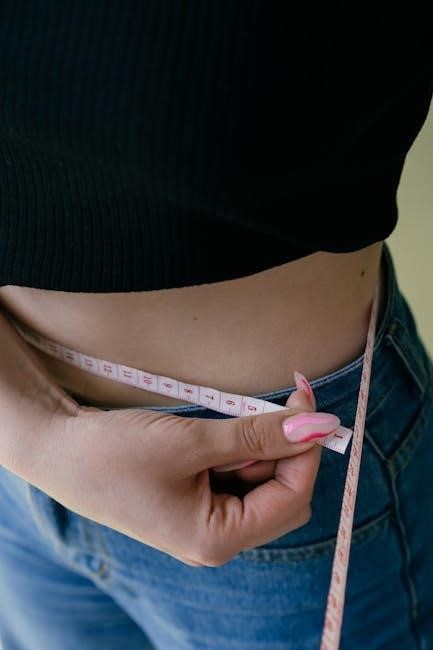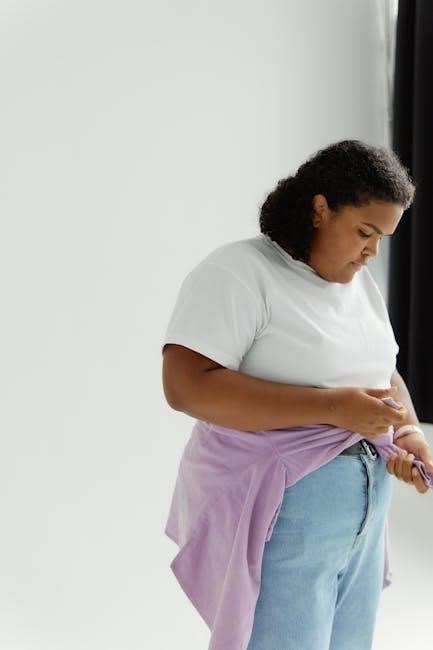Understanding women’s jeans sizing is crucial for a perfect fit. This guide explores measurements, size systems, and styles to help you find your ideal pair effortlessly.
1.1 Understanding the Importance of Proper Fit

A proper fit in women’s jeans is essential for both comfort and confidence. Ill-fitting jeans can cause discomfort, restrict movement, or appear unflattering, regardless of style. A well-fitting pair enhances your silhouette, boosts confidence, and ensures all-day comfort. Proper fit also prevents issues like gaping waistbands or tight seams, which can ruin the overall look. Investing time in finding the right size ensures your jeans look and feel their best, making them a versatile staple in your wardrobe. Remember, the right fit balances style and comfort, ensuring you feel great in your own skin.
1.2 Overview of Women’s Jeans Size Systems
Women’s jeans size systems vary globally, with numerical and alphabetical sizing being the most common. Numerical sizes (e.g., 28, 30) are often used in the US, while alphabetical sizes (S, M, L) are popular elsewhere. International size standards differ, with countries like Germany and Italy having their own systems. Some brands also offer petite or plus sizes. Understanding these systems is key to finding the right fit. Additionally, size charts often include measurements for waist, hip, and inseam, helping you match your body measurements to the correct size. Always refer to the brand’s specific size guide for accuracy.
How to Measure Yourself for Jeans
Accurate measurements are key to finding the perfect fit. Measure your waist, hips, and inseam using a flexible tape measure. Keep the tape level and not too tight for consistent results.
2.1 Measuring Waist Size
To measure your waist, locate the smallest part of your natural waistline, typically just above the belly button. Wrap a flexible tape measure around this area, ensuring it’s level and not too tight. The tape should feel comfortable, neither digging into your skin nor sagging. Take note of the measurement in inches or centimeters. This will help determine your jeans size accurately. For low-waisted styles, measure about 4 inches below your natural waist. Always stand up straight during measurement for the most precise result.

2.2 Measuring Hip Size
To measure your hip size, stand up straight and wrap a flexible tape measure around the fullest part of your hips and buttocks. This is typically about 7-9 inches (18-23 cm) below your waistline. Ensure the tape is level and not twisted. The measurement should be snug but not tight, providing an accurate reflection of your hip circumference. This measurement is crucial for determining the best fit in jeans, especially for styles that accentuate or fit closely around the hips. Record the measurement in inches or centimeters for reference when using a size chart.
2.3 Measuring Inseam
The inseam is the inside length of the pants, measured from the crotch seam to the bottom of the pant leg. To measure accurately, stand straight and place the tape measure along the inside of your leg, starting at the crotch and ending at the ankle bone. This measurement determines the pant length and is essential for ensuring the jeans are neither too short nor too long. Inseam lengths vary by style, with options like petite, regular, and long/tall. A well-fitted inseam ensures comfort and the desired aesthetic, whether for skinny jeans or relaxed fits.
Understanding Women’s Jeans Size Charts
Women’s jeans size charts help determine the perfect fit by using waist, hip, and inseam measurements. Sizes vary by brand and country, often including numerical and alphabetical options.
3.1 Numerical vs. Alphabetical Sizing
Women’s jeans sizing varies between numerical and alphabetical systems. Numerical sizes (e.g., 28, 30) are based on specific measurements, offering a more precise fit. Alphabetical sizes (S, M, L) are less exact, fitting a range of body types. Some brands combine both systems for clarity. Numerical sizing is often preferred for accuracy, while alphabetical is more general. Understanding these differences helps in selecting the right size, especially when shopping across brands or internationally. Always refer to the brand’s size chart for the best fit, as sizing standards can vary significantly.
3.2 International Size Standards
Women’s jeans sizing varies globally, with different regions using unique standards. For example, European sizes often correspond to numerical measurements, while U.S. sizes combine numerical and alphabetical systems. International brands may adapt their sizing to local standards, causing inconsistencies. Understanding these differences is key when shopping across borders. For instance, a size 28 in the U.S. may equate to a 38 in Europe. Always refer to the brand’s size chart, as global sizing standards are not universally aligned. This variation can make finding the perfect fit challenging but manageable with careful measurement and comparison.
3.3 Size Variations Across Brands
Jeans sizes can vary significantly between brands due to differences in sizing standards and fit philosophies. Some brands may use vanity sizing, where sizes are labeled larger than actual measurements to boost customer confidence. Others cater to specific body types, such as petite or tall frames, affecting inseam and overall fit. Fabric stretch and cut also influence how sizes feel. For example, one brand’s size 8 might fit differently from another’s. Always consult the brand’s size chart and consider fabric composition to ensure the best fit. These variations make it essential to try jeans on or use precise measurements when shopping online.
How Jeans Sizes Differ by Brand
Jeans sizes vary by brand due to differences in fit, fabric, and sizing standards. Some brands use vanity sizing, while others cater to specific body types or styles.
4.1 Understanding Vanity Sizing
Vanity sizing refers to the practice where brands label clothing with larger sizes than the actual measurements to boost customer confidence. This leads to inconsistency across brands, as sizes like “8” or “10” may vary significantly. For example, one brand’s size 8 might fit like another’s size 10. This makes it challenging for consumers to rely solely on size numbers. Vanity sizing is common in the fashion industry, particularly in women’s jeans, where body positivity and perceived size play a role. Always check measurements or try clothes on to ensure the best fit, as sizes are not standardized.
4.2 Brand-Specific Fit Differences
Jeans fit varies significantly between brands due to differing design approaches and sizing standards. Some brands offer a relaxed fit, while others cater to slim or athletic builds. Measurements like waist, hip, and inseam can differ slightly, leading to inconsistent sizes. For example, one brand’s size 8 might be another’s size 10. This variability makes it essential to consult each brand’s size chart. Additionally, fabric stretch and cut style (e.g., high-waisted, skinny) impact fit. Always try jeans on if possible or refer to brand-specific guides to ensure the best fit, as there is no universal sizing standard across brands.

Common Jeans Styles and Their Fits
From skinny to straight-leg, bootcut, and high-waisted, each style offers a unique fit catering to different body types and fashion preferences, ensuring comfort and flattering silhouettes.
5.1 Skinny Jeans Fit Guide
Skinny jeans are designed to fit tightly from waist to ankle, creating a sleek, streamlined look. They are ideal for highlighting curves and pairing with oversized tops or jackets.
- Measure your waist and hips to ensure a snug but comfortable fit.
- Look for stretch fabric for added flexibility and all-day comfort.
- Pair with heels or ankle boots to elongate the legs.
- Balance proportions with loose-fitting tops or cropped jackets.
Perfect for most body types, skinny jeans offer a versatile and trendy option for casual or dressed-up outfits.
5.2 Straight-Leg Jeans Fit Guide
Straight-leg jeans offer a classic, timeless style with a straight cut from thigh to ankle. They sit comfortably on the natural waist and are versatile for most body types.
- Measure your waist and hips for the best fit, ensuring comfort and mobility.
- Pair with boots for a rugged look or flats for a casual vibe.
- Balance proportions with tailored tops or jackets for a polished appearance.
- Perfect for everyday wear, straight-leg jeans are a wardrobe staple.
This style suits various body types, offering a balanced fit that’s neither too tight nor too loose.
5.3 Bootcut and Flare Jeans Fit Guide
Bootcut and flare jeans feature a wider leg opening, starting from the knee down, creating a balanced silhouette. These styles are ideal for pear-shaped bodies, as they draw attention away from the hips and thighs.
- Bootcut jeans have a subtle flare, while flare jeans are more dramatic, offering a retro vibe.
- They pair well with heels or boots, elongating the legs and enhancing proportions.
- Measure your waist, hips, and inseam to ensure the perfect fit for these styles.
- Flare jeans are great for tall women, as they create a balanced look with heels.
Both styles are comfortable and versatile, suitable for casual and dressy outfits alike.
5.4 High-Waisted Jeans Fit Guide
High-waisted jeans sit above the natural waistline, offering a comfortable and flattering fit. They are ideal for elongating the torso and providing support.
- Measure your natural waist to ensure the perfect fit, as high-waisted jeans are designed to sit snugly above the hips.
- They are versatile, suitable for all body types, and can be styled casually or dressed up.
- Pair with cropped tops or tucked-in blouses to accentuate the waistline.
- High-waisted jeans are great for creating a balanced look with boots or heels.
They offer both comfort and style, making them a wardrobe staple for many women.

The Role of Inseam in Jeans Sizing
Inseam measures the inside length of jeans from crotch to hem, impacting fit and style. Proper inseam ensures jeans sit correctly on the leg, avoiding excess fabric.
6.1 Understanding Inseam Measurements
Inseam refers to the inside length of jeans, measured from the crotch seam to the bottom hem. Accurate inseam measurements ensure proper fit and comfort. Jeans with the right inseam avoid dragging or feeling too short. Inseam varies by style, with options like “short,” “regular,” and “long” to suit different heights and preferences. Measuring inseam correctly helps in selecting jeans that align with your body proportions, ensuring a balanced look and optimal comfort. This measurement is essential for achieving the perfect fit, whether for casual or formal wear.
6.2 How Inseam Affects Fit
Inseam significantly impacts the fit and comfort of jeans. A correct inseam ensures the jeans sit properly on the leg, avoiding bunching or restriction. If the inseam is too long, the jeans may drag or fold at the ankle, while a short inseam can feel tight around the calves. Proper inseam length ensures a smooth fit, preventing discomfort and enhancing the overall appearance. It also influences the style, as certain inseam lengths are better suited for specific body types or activities. Choosing the right inseam is essential for both functionality and fashion.
Waist Types and Jeans Fit
Waist types significantly influence jeans fit. Natural, low, and high-waisted styles cater to different body types and preferences, ensuring comfort and a flattering silhouette for every woman.
7.1 Natural Waist vs. Low Waist
The natural waist is the narrowest part of your torso, typically just above the belly button. Low-waisted jeans sit about 4 inches below this point, offering a relaxed fit. Natural waist jeans provide better support and definition, while low-waisted styles are trendy and comfortable. Measuring accurately is key to choosing the right style for your body type and personal preference. Understanding these differences helps in selecting jeans that flatter your figure and ensure a comfortable, confident fit.
7.2 High-Waisted vs. Mid-Waisted Jeans
High-waisted jeans sit just below the belly button, offering more coverage and support. They are ideal for elongating the torso and creating a balanced silhouette. Mid-waisted jeans, however, sit between the natural and low waist, providing a moderate rise. Both styles cater to different body types and preferences. High-waisted jeans are great for those seeking comfort and a retro look, while mid-waisted options offer a modern, versatile fit. Understanding these differences helps in selecting jeans that align with your personal style and body proportions for optimal comfort and confidence.

Tips for Choosing the Right Jeans Size
Consider stretch, fabric type, and potential shrinkage. Measure accurately and refer to size charts. Try jeans on if possible for the best fit and comfort.
8.1 Considering Stretch and Fabric
When choosing jeans, consider the fabric’s stretch and composition. High-stretch fabrics like elastane blends offer flexibility and comfort, while non-stretch fabrics provide structure. Cotton-rich jeans are durable but may shrink slightly. Polyester adds resilience but can feel less breathable. Tencel or bamboo fabrics offer softness and sustainability. Always check the care label to ensure the fabric meets your lifestyle needs. Stretchy jeans may fit tighter initially but relax over time. Non-stretch styles maintain their shape but may feel stiffer. Choose based on your activity level and desired comfort to ensure the best fit and longevity of your jeans.

8.2 How to Adjust for Shrinking
Jeans made from natural fibers like cotton may shrink slightly after washing. To account for this, consider buying a size slightly larger than your measured fit. Always check the care label for specific washing instructions. Pre-washing jeans before hemming or altering ensures the fit remains accurate. If you prefer a snug fit, shrinkage can work in your favor, but if you like a looser style, opt for a larger size. Fabric type matters—stretchy jeans are less likely to shrink than 100% cotton styles. Measure carefully and consider shrinkage when selecting your perfect pair for long-lasting comfort and fit.

Common Mistakes When Buying Jeans
Ignoring body type and relying solely on size numbers are frequent errors. Not considering fabric stretch or shrinkage can also lead to poor fit choices.
9.1 Relying Solely on Size Numbers
Relying only on size numbers can lead to poor fits, as sizes vary between brands due to factors like vanity sizing and differences in measurement standards. Many women assume their usual size will fit, but this ignores body type, fabric stretch, and style differences. For example, a size 8 in one brand might fit differently in another. To avoid this, always measure yourself and refer to the brand’s size chart. Additionally, consider the jeans’ style, as skinny, straight-leg, or bootcut fits may require adjustments. Ignoring these details can result in jeans that are too tight or too loose, wasting time and money.
9.2 Not Considering Body Type
Ignoring your body type when buying jeans can result in an unflattering fit. For example, pear-shaped women may find skinny jeans accentuate their hips, while petite women might feel overwhelmed by oversized styles. Hourglass figures often benefit from high-waisted jeans, while rectangular body types may prefer styles with more texture or detailing. Failing to consider these factors can lead to discomfort and a lack of confidence. Always choose jeans that complement your natural shape, ensuring a balanced and flattering appearance. This approach ensures a more personalized fit, making your jeans both functional and stylish for your unique body type.

How to Use a Jeans Size Chart Effectively
Measure your waist, hips, and inseam accurately, then compare to the chart. Consider fabric stretch and style to ensure the best fit and confidence.
10.1 Matching Measurements to Sizes
Accurately measure your waist, hips, and inseam, then align these with the size chart. Compare your numbers to the chart’s corresponding sizes, noting any brand-specific variations. Consider fabric stretch and style differences, as these can affect fit. If your measurements fall between sizes, choose based on comfort preference. Double-check international size standards if needed. This step ensures a tailored fit, boosting confidence and comfort. Remember, sizing can vary, so trust your measurements over size labels for the best result.
10.2 Interpreting Size Chart Data
Size charts provide standardized measurements for waist, hip, and inseam. To interpret effectively, match your measurements to the closest size. Note that numerical and alphabetical sizes correspond to specific body dimensions. International standards may vary, so check the chart’s origin. Pay attention to brand-specific adjustments, as sizing can differ. Fabric type and stretch also influence fit. If your measurements fall between sizes, consider comfort and style preferences. Always cross-reference your data with the chart to ensure accuracy. This step ensures a precise fit, making your jeans comfortable and flattering. Trust the chart to guide your selection for the best outcome.
The Future of Jeans Sizing
The future of jeans sizing lies in technology, with AI and 3D scanning enabling custom fits. Bespoke options and sustainable practices will redefine how women shop for jeans.
11.1 Technology in Sizing
Technology is revolutionizing women’s jeans sizing through AI, 3D scanning, and augmented reality. These tools create precise body avatars, ensuring accurate measurements and personalized fits. Apps now offer virtual try-ons, allowing women to see how jeans fit without physical trials. Machine learning algorithms analyze body types and preferences to recommend sizes, reducing sizing errors. Advanced systems also integrate data from various brands, providing a universal sizing solution. This tech-driven approach not only enhances convenience but also promotes sustainability by minimizing returns and waste. The future of jeans sizing is increasingly digital, offering women a seamless and tailored shopping experience.
11.2 Custom and Bespoke Options
Custom and bespoke jeans options are gaining popularity, offering women tailored fits based on precise measurements. Brands now provide made-to-measure services, ensuring jeans are crafted to individual body types. Advanced technologies like 3D scanning and virtual try-ons enable accurate sizing without physical fittings. Some brands even allow customization of styles, washes, and details, creating unique pieces. This shift toward personalization addresses the limitations of standard sizing, offering a more inclusive and sustainable approach. Bespoke jeans not only enhance comfort but also reduce waste, making them a desirable choice for those seeking perfection in their denim.
Conclusion
Finding the perfect pair of jeans is achievable by understanding measurements, size charts, and personal fit preferences. Confidence starts with the right fit—experiment and enjoy your denim journey!
12.1 Final Tips for Finding Your Perfect Fit
Always measure yourself accurately and refer to size charts for guidance. Consider fabric stretch and how jeans may shrink. Try different styles to see what flatters your body type. Don’t hesitate to explore various brands, as sizing can vary. Pay attention to inseam lengths for the perfect pant length. If possible, try jeans on before buying to ensure comfort and fit. Seek a second opinion or use online reviews for insights. Remember, the right fit is personal—trust your instincts and enjoy the process of finding your perfect pair of jeans.

12.2 Encouragement to Experiment
Don’t be afraid to try new styles, sizes, and brands to discover what works best for you. Experimenting with different fits and fabrics can help you find jeans that make you feel confident and comfortable. Remember, sizing varies, so don’t be discouraged if your size differs across brands. Try on multiple options, and don’t hesitate to seek a second opinion. Embrace the process of finding your perfect fit—it’s a journey, and there’s no one-size-fits-all solution. Keep an open mind, and enjoy exploring the wide variety of jeans available to suit your unique style and body type.
